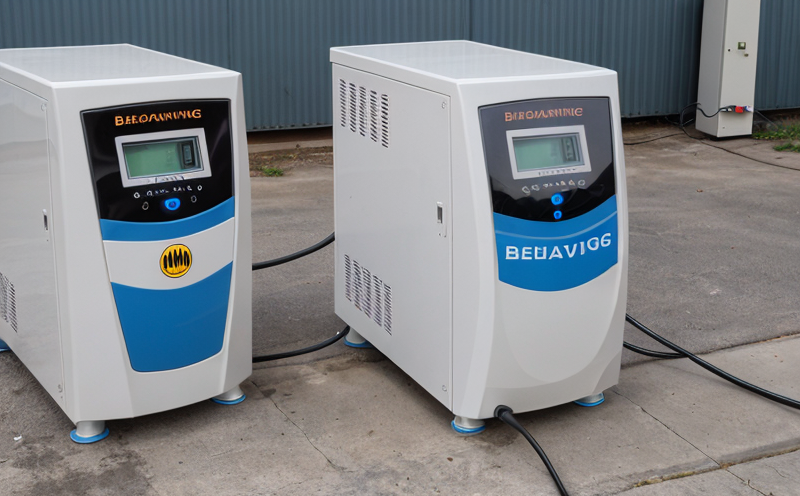NF EN 62133 Charging and Discharging Behavior Testing of Secondary Portable Batteries
The NF EN 62133 standard is pivotal in ensuring that secondary portable batteries, such as lithium-ion (Li-ion), lead-acid, nickel-cadmium (NiCd), and others, meet stringent safety, performance, and environmental requirements. This testing protocol evaluates the charging and discharging behavior of these batteries to ensure they operate reliably under various conditions.
Secondary portable batteries are crucial components in a wide array of consumer electronics, including smartphones, laptops, power tools, electric vehicles, and medical devices. Ensuring their safe and efficient operation is critical for both manufacturers and users. NF EN 62133 provides a comprehensive framework to test these batteries' performance parameters such as capacity retention, charge acceptance, self-discharge rate, and over-temperature protection.
The standard covers the testing of secondary portable batteries under specified conditions that simulate real-world usage scenarios. This includes charging at various rates, discharging at different depths, and holding states for extended periods. The goal is to assess how well these batteries perform in challenging environments, which can range from extreme temperatures to high charge currents.
In the context of secondary portable batteries, understanding their behavior under varying conditions is vital. This knowledge helps manufacturers design products that are both safe and efficient. By adhering to NF EN 62133, laboratories like ours ensure compliance with international safety standards, enhancing product reliability and user confidence.
The testing process involves precise instrumentation and controlled environments to replicate the operational stressors encountered by these batteries in everyday use. This includes simulating fast charging, deep discharging cycles, and prolonged periods of holding at different states of charge. The results provide critical insights into the battery's performance characteristics, which are essential for ongoing product development.
Compliance with NF EN 62133 is mandatory for manufacturers aiming to distribute their products in Europe. This standard not only ensures safety but also promotes environmental responsibility by reducing battery waste through the provision of consistent testing protocols.
Why It Matters
The importance of NF EN 62133 cannot be overstated, especially for manufacturers and quality managers who are responsible for ensuring product safety and performance. By adhering to this standard, organizations can enhance their reputation by demonstrating a commitment to excellence in product design and production.
Compliance with the standard is crucial for several reasons:
- It ensures that batteries meet stringent safety requirements, reducing the risk of fires or explosions.
- It promotes environmental responsibility by ensuring that batteries are more durable and efficient, thus extending their lifespan.
- It provides a benchmark for quality control, allowing manufacturers to monitor and improve product performance over time.
The benefits extend beyond just compliance; they also include improved brand reputation and enhanced customer trust. By demonstrating adherence to international standards, companies can build stronger relationships with regulatory bodies and customers alike.
Applied Standards
| Standard | Description |
|---|---|
| NF EN 62133-1 | General requirements for secondary portable batteries and battery packs. |
| NF EN 62133-2 | Detailed test procedures for charging behavior testing. |
| NF EN 62133-3 | Detailed test procedures for discharging behavior testing. |
| Standard | Description |
|---|---|
| NF EN 62133-4 | Detailed test procedures for holding state tests. |
| NF EN 62133-5 | Requirements and test methods for battery packs with a rated energy exceeding 8 kWh. |
The NF EN 62133 series of standards provides comprehensive guidance on the testing procedures required to ensure that secondary portable batteries meet all safety, performance, and environmental requirements. By adhering to these standards, manufacturers can be confident in their product's compliance with international regulations.
Benefits
The benefits of implementing NF EN 62133 charging and discharging behavior testing are manifold:
- Enhanced Safety: Ensures that batteries operate safely under all conditions, reducing the risk of accidents.
- Improved Performance: Provides critical data on battery performance, which can be used to optimize product design.
- Environmental Responsibility: Promotes the use of more durable and efficient batteries, thus extending their lifespan and reducing waste.
- Regulatory Compliance: Ensures that products meet all necessary safety and environmental regulations, facilitating easier market entry.
- Better Brand Reputation: Demonstrates a commitment to excellence in product design and production, enhancing brand reputation.
- Informed Decision-Making: Provides data-driven insights into battery performance, enabling informed decision-making for ongoing product development.
By adhering to NF EN 62133, manufacturers can ensure that their products are not only safe but also reliable and efficient. This commitment to quality and safety is essential in today's competitive market environment.





